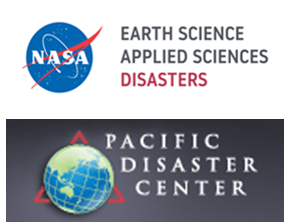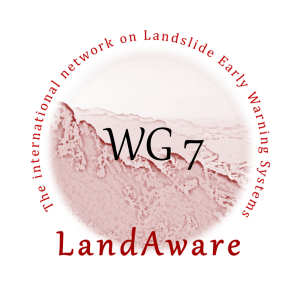The recordings of the webinar by NASA and Pacific Disaster Center on Landslide Hazard Awareness held on April 11, 2024 (info here) can be found on the LandAware YouTube channel:


The recordings of the webinar by NASA and Pacific Disaster Center on Landslide Hazard Awareness held on April 11, 2024 (info here) can be found on the LandAware YouTube channel:
The webinar “Landslide Hazard Awareness – NASA and Pacific Disaster Center cooperation to support decision-making” is scheduled for April 11, 2024 in the following time slots:
1:00 p.m-2:30 p.m. (EST)
11:00 a.m. 12:30 p.m. (Centro América)
7:00 p.m.-8:30 p.m. (CEST)
To join the webinar use the following link
Key objectives:
Present Research Findings and showcase the partnership between NASA and the Pacific Disaster Center (PDC) in leveraging advanced technologies and data to improve landslide hazard assessment and decision-making processes. Introduce participants to the various tools, platforms, and resources developed through the collaboration between NASA and the PDC, such as landslide risk maps, and decision support tools.
Expected outcomes:
At the end of the webinar, it is expected that participants will have gained a better understanding of the actions and strategies implemented by the organizations involved in the region and that concrete opportunities for future collaboration will have been identified. In addition, it seeks to foster a renewed commitment to risk reduction and resilience in Central America.
Expected audience:
The webinar is open to all LandAware associates in particular those from the LatinAmerica region or working with landslide early warning systems in the region. The webinar is aimed in particular at the network on landslides in Central America made up of experts from official institutions in Central American countries, such as INSIVUMEH of Guatemala, INETER of Nicaragua, SGR of Costa Rica, SINAPROC of Panama, COPECO of Honduras, and MARN of El Salvador.
Next steps – After the webinar:
A monitoring process will be carried out that will include preparing a report with the conclusions and recommendations that emerged during the event. In addition, the possibilities of establishing working groups or joint projects will be explored to advance risk reduction in the region.
Organizers:
Ricardo Quiroga: NASA Disasters Coordinator
Graziella Devoli: LandAware EC member/Norwegian Water Resources and Energy Directorate (NVE)
Presenters:
Thomas Stanley LinkedIn
Greg Hampe LinkedIn
Robert Emberson LinkedIn
Duration: 90 minutes
Agenda:

News received from
Paulo Hader (PrimeIT, Brazil), Graziella Devoli (NVE, Norway)
Save the date for the Second regional meeting for Brazil (in Portuguese) organized by the WG7 Operational LEWS to establish contact among members from the same country/region, to exchange experience and to know about projects in the region and possibly to promote future collaborations among LandAware associates and observers.
Monday, 30th of October
– 18:00 (Brazilian Time, São Paulo/Rio de Janeiro)
– 22:00 Central Europe Time, CET.
Link to join the meeting:
https://meet.google.com/rda-xwga-aco
NEWS received from
Mario Reyes (MARN, El Salvador), Graziella Devoli (NVE, Norway)
SAVE THE DATE for the 2nd regional meeting for the Latin American region (in Spanish) organized by the WG7 Operational LEWS to establish contact among members from the same country/region, to exchange experience and to know about projects in the region and possibly to promote future collaborations among LandAware associates and observers.
Wednesday, 24th of May 2023
– 1:00 PM Ciudad de Guatemala time
– 21:00 PM Central Europe summer time, CEST
Click here to join the meeting
Haga clic aquí para participar en la reunión
Klikk her for å bli med i møtet

NEWS received from
Graziella Devoli – NWE Norway
The LandAware WG7 – Operational LEWS is organizing three regional meetings to establish contact among members from the same country/region, to exchange experiences and to know about projects in the region and possibly to promote future collaborations among LandAware associates and observers. We would like to have the opportunity to discuss the status of landslide early warning systems in the region, needs, resources and limitations that delay or have delayed the organization of operational LEWS.
— — —
1. Meeting Latin America (in Spanish):
Wednesday 29th of June 2022 (at 8:00 AM Ciudad de Guatemala time, 16:00 CEST).
— —
2. Meeting Brazil (in Portuguese):
Monday 4th of July 2022 (at 18:00 Rio de Janeiro time, 23:00 CEST).
— —
3. Meeting Indian-Himalayan region (in English):
Wednesday 13 of July for India (18:00 Mumbai time, 14:30 CEST).
— —
Please forward this invitation to other colleagues that could be interested in this topic even if they are not part of the LandAware network.
For problem with the link, contact Graziella Devoli gde@nve.no
Best regards,
Graziella Devoli, Paulo Hader, Sesha Ammavajjala
NEWS received from
Graziella Devoli – NVE, Norway
New conference proceedings “Seven years of landslide forecasting in Norway – Strengths and limitations” presented at 5th World landslide Forum, Kyoto, Japan (WLF5 | World Lanslide Forum 5 (iplhq.org))
In this short paper, the authors summarize the experiences acquired by the Norwegian Landslide Forecasting and Warning Service during the first 7 years (between 2013 and 2019) of operation and discuss some of the main strengths and limitations of the service. The authors recognize that the major strengths of the service were the national political will (towards the creation of such of service), the assignation of the landslide forecasting service to an existing well consolidated flood warning service, the strong collaboration across public agencies and the multidisciplinary approach. The existence of a national landslide database and of an operational distributed hydrological model were essential for the rapid establishment of relationships between landslides events and hydro-meteorological conditions. A strong development of IT-tools and expansion of the meteorological and hydrological network was also crucial. Several are the challenges and limitations, among them: an insufficient process-understanding of rainfall- and snowmelt-induced landslides, the difficult and tedious task of verifying landslide occurrence after a warning is sent and, the prediction of landslides triggered by local intense rain showers during summer, and by rapid snowmelt events during winter, due to the limitations that exist in the models and thresholds currently in use.
Reference: Devoli G., Colleuille H., Sund M., Wasrud J. (2021). Seven Years of Landslide Forecasting in Norway—Strengths and Limitations. In: Springer Nature Switzerland AG 2021, N. Casagli et al. (eds.), Understanding and Reducing Landslide Disaster Risk, ICL Contribution to Landslide Disaster Risk Reduction, https://doi.org/10.1007/978-3-030-60311-3_30 (pages 267-274)